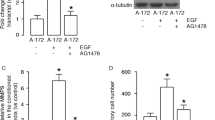Abstract
The molecular mechanism underlying cancer invasiveness and metastasis of larynx carcinoma remains elusive. Here we reported a strong correlation between phosphorylated epidermal growth factor receptor (EGFR) and matrix metalloproteinase-7 (MMP7) levels in larynx carcinoma patients. To examine whether a causal link exists, we used a human larynx carcinoma line, Hep-2, to study the molecular basis of EGFR signaling and MMP7 activation. We found that EGF-induced EGFR phosphorylation in Hep-2 cells resulted in activation of MMP7 and, consequently, an increase in cancer invasiveness. An EGFR inhibitor efficiently blocked this EGF-induced activation of MMP7. Moreover, an inhibitor for PI3 kinase (PI3K)/Akt, but not an inhibitor for mitogen-activated protein kinase (MAPK) or an inhibitor for c-Jun N-terminal kinase (JNK), significantly inhibited the EGF-induced activation of MMP7, suggesting that PI3K/Akt signaling cascades may be responsible for EGF-activated MMP7. Further dissection of the pathway revealed that nuclear exclusion of Akt downstream target, FoxO1, was induced by EGF-induced Akt activation and could be inhibited by either the EGFR inhibitor or by the PI3K/Akt inhibitor. Expression of a constitutive nuclear form of FoxO1 significantly inhibited MMP7 activation induced by EGF. Taken together, these findings suggest that EGF/EGFR signaling activates downstream PI3K/Akt to induce FoxO1 nuclear exclusion, which activates MMP7 to promote larynx carcinoma metastasis. Thus, Akt and FoxO1 appear to be promising therapeutic targets for preventing the metastasis of larynx carcinoma.




Similar content being viewed by others
References
Nadal A, Cardesa A. Molecular biology of laryngeal squamous cell carcinoma. Virchows Arch. 2003;442:1–7.
Dufour A, Overall CM. Missing the target: matrix metalloproteinase antitargets in inflammation and cancer. Trends Pharmacol Sci. 2013;34:233–42.
Ii M, Yamamoto H, Adachi Y, Maruyama Y, Shinomura Y. Role of matrix metalloproteinase-7 (matrilysin) in human cancer invasion, apoptosis, growth, and angiogenesis. Exp Biol Med (Maywood). 2006;231:20–7.
Burke B. The role of matrix metalloproteinase 7 in innate immunity. Immunobiology. 2004;209:51–6.
Wielockx B, Libert C, Wilson C. Matrilysin (matrix metalloproteinase-7): a new promising drug target in cancer and inflammation? Cytokine Growth Factor Rev. 2004;15:111–5.
Li Z, Zhang D, Zhang H, Miao Z, Tang Y, Sun G, et al. Prediction of peritoneal recurrence by the mRNA level of CEA and MMP-7 in peritoneal lavage of gastric cancer patients. Tumour Biol. 2014;35:3463–70.
Koskensalo S, Louhimo J, Nordling S, Hagstrom J, Haglund C. MMP-7 as a prognostic marker in colorectal cancer. Tumour Biol. 2011;32:259–64.
Koskensalo S, Mrena J, Wiksten JP, Nordling S, Kokkola A, Hagstrom J, et al. MMP-7 overexpression is an independent prognostic marker in gastric cancer. Tumour Biol. 2010;31:149–55.
Tanimoto H, Underwood LJ, Shigemasa K, Parmley TH, Wang Y, Yan Y, et al. The matrix metalloprotease pump-1 (MMP-7, matrilysin): a candidate marker/target for ovarian cancer detection and treatment. Tumour Biol. 1999;20:88–98.
Kim S, Choi JH, Lim HI, Lee SK, Kim WW, Cho S, et al. EGF-induced MMP-9 expression is mediated by the JAK3/Erk pathway, but not by the JAK3/STAT-3 pathway in a SKBR3 breast cancer cell line. Cell Signal. 2009;21:892–8.
Schneider MR, Wolf E. The epidermal growth factor receptor ligands at a glance. J Cell Physiol. 2009;218:460–6.
Hirsch FR, Janne PA, Eberhardt WE, Cappuzzo F, Thatcher N, Pirker R, et al. Epidermal growth factor receptor inhibition in lung cancer: status 2012. J Thorac Oncol. 2013;8:373–84.
Kobayashi K, Hagiwara K. Epidermal growth factor receptor (EGFR) mutation and personalized therapy in advanced nonsmall cell lung cancer (NSCLC). Target Oncol. 2013;8:27–33.
Sasaki T, Hiroki K, Yamashita Y. The role of epidermal growth factor receptor in cancer metastasis and microenvironment. BioMed Res Int. 2013;2013:546318.
Monsalve M, Olmos Y. The complex biology of FOXO. Curr Drug Targets. 2011;12:1322–50.
Biggs 3rd WH, Meisenhelder J, Hunter T, Cavenee WK, Arden KC. Protein kinase B/Akt-mediated phosphorylation promotes nuclear exclusion of the winged helix transcription factor FKHR1. Proc Natl Acad Sci U S A. 1999;96:7421–6.
Acknowledgments
This work was supported by the Key Project of Shanghai Committee of Science and Technology, China (No. 12JC1402102), the National Natural Science Foundation of China (No. 81302004), and the Comprehensive Prevention and Control Project of Chronic Disease of Shanghai Shenkang Hospital Development Center, China (No. SHDC12012317).
Conflicts of interest
The authors have declared that no competing interests exist.
Author information
Authors and Affiliations
Corresponding authors
Additional information
The Publisher and Editor retract this article in accordance with the recommendations of the Committee on Publication Ethics (COPE). After a thorough investigation we have strong reason to believe that the peer review process was compromised.
An erratum to this article is available at http://dx.doi.org/10.1007/s13277-017-5487-6.
About this article
Cite this article
Ding, H., Zhu, Y., Chu, T. et al. RETRACTED ARTICLE: Epidermal growth factor induces FoxO1 nuclear exclusion to activate MMP7-mediated metastasis of larynx carcinoma. Tumor Biol. 35, 9987–9992 (2014). https://doi.org/10.1007/s13277-014-2067-x
Received:
Accepted:
Published:
Issue Date:
DOI: https://doi.org/10.1007/s13277-014-2067-x




